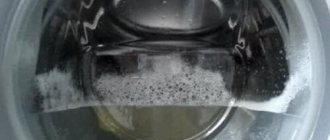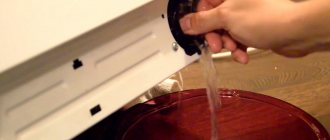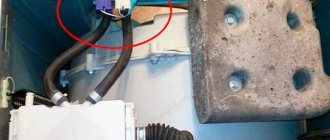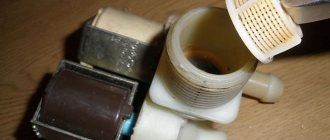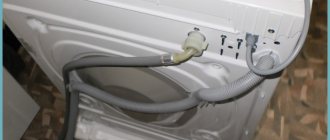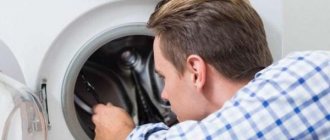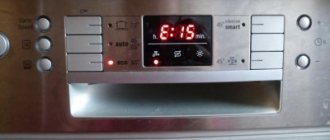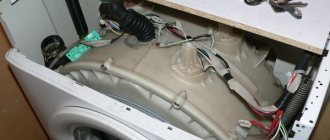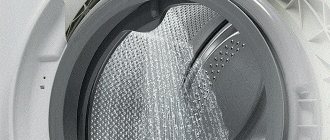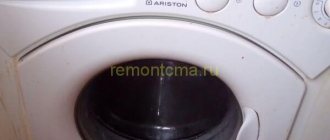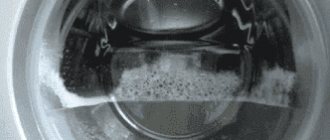You put in the laundry, set the program, pressed “start”, but you can’t hear the usual murmur of water being poured. The washing machine does not fill with water, but lights are shining. Let's figure out what to do and what the reasons are. You can call a specialist and pay for repairs if you have time and money - but if you have a little technical knowledge, simple tools and desire - you can fix the machine yourself.
The instructions are suitable for most makes and models of cars, including AEG, Bosch Maxx, Electrolux EWS, Hotpoint Ariston Margarita, Ardo, Beko, Indesit, Zanussi, Kaiser / Kaiser, LG / LG, Haier / Haer, Samsung EcoBubble / Samsung Eco Bubble, Candy / Kandy, Daewoo / Daewoo, Whirlpool / Whirlpool and other models with direct and belt drive.
First let's check
Problems with the washing program
First check the mode in which the machine operates. Try canceling the wash. If the problem does not disappear, reboot the machine by turning it off from the network for 10-15 seconds. If there was a software failure in the controller, when turned on, water will begin to accumulate.
Puddles on the floor
If puddles appear under the machine, carefully inspect it from all sides.
- The tank leaked
- The pipe inside the housing has burst or become deformed,
- The inlet hose has broken or the fitting that connects the device to the water supply has come off.
Availability of water in the tap
Then we will check if there is water in the apartment. If there is no water, but it was not turned off in the house, you may have turned off the cold water inlet tap (usually there is a meter on it).
Display messages
Some machines indicate a fault on the display. In this case, look for instructions and follow the manufacturer’s instructions. Our error, for example, is indicated by the codes:
- Ardo, Asko, Candy, Hansa, Kaiser: E02 - error when setting the water level
- Beko: H4 - the water filling valve is closed
- Bosch, Siemens: F02 - water does not enter the drum
- Electrolux, Zanussi: E11 - error when filling the tank with water (it takes too long to fill), E13 - drop in water level due to a leak
- Gorenje: F2 - water intake limit exceeded
- LG: IE - impossible to get water
- Samsung: E1 - water was filled with an error
- Whirlpool: E10 - the machine does not fill with water
- Atlant: F5 - water is drawn in and drained at the same time, the inscription "door" - the door is not closed tightly enough
If the problem cannot be solved, we begin a sequential detailed analysis.
Types of possible faults
The reasons why the washing machine does not fill with water may be due to improper operation of the unit or failure of its individual elements. Such problems include:
- lack or low pressure in the inlet hose due to problems in the water supply system;
- clogging of the inlet hose or cleaning filter at the entrance to the machine;
- loose closure of the car door when the door lock does not work;
- breakage or damage to the insulation of connecting electrical wires;
- failure of the intake valve;
- damage to the door lock;
- malfunction of the liquid level sensor (pressostat);
- failures in the software control module.
In some cases, it is enough to simply fix the problem (open the tap, slam the door, etc.); other problems require repair or replacement of failed spare parts.
Causes, diagnosis and treatment
Water fills slowly or does not flow
Check the pressure in the tap - the stream should be good, not just a trickle. If everything is fine with the pressure, we move on.
First of all, remove the top cover, turn on the machine for washing and listen to see if the water fill solenoid is working. If the characteristic sound of the electromagnet is heard, this means that the control controller has given a command to fill, the valve is working to open, but there is no water.
Close the water supply tap and carefully unscrew the hose from the fitting using the machine (preferably by hand, because it is plastic). Carefully pour water into the prepared container. If the water comes out, the tap and hose are fine. If not, look further.
The filter is clogged
Check to see if the washing machine inlet filter is clogged. If it is clogged, remove it using pliers, clean it, check the condition of the gasket, connect the hose, and turn it on. If water still does not flow, move on.
The door is not closed tightly
When you have loaded the laundry and closed the machine door, it is locked with a special lock - the hatch locking device (UBL). If you start the wash, the device tells the controller that the hatch is closed and the machine is ready for use. If there is no such command, the controller does not let water in.
To begin, tighten the hatch fastening screws and close the door, pressing the hatch tightly. If water starts to flow, the problem is the wear of the mechanical part of the fasteners. The hinges and latches need to be tightened. If it doesn't help, change the lock.
More details about UBL breakdowns:
5 ways to emergency open the washing machine door after washing
Checking the inlet valve and its windings
To check the valve, we need a multimeter with the ability to measure resistance up to 5 kOhm.
- Checking resistance. Remove the top cover of the machine. The valve is located on the opposite side of the water supply hose. Let's measure the resistance of the windings. There should be values in the range of 2.5–4 kOhm. If the instrument readings are different, the valve must be replaced.
- Checking the power supply to the valve. We turn on the machine in rinse mode and measure the voltage at the valve terminals. If there is 220 volts, then this means that the control controller gives a command to fill in water, but the solenoid does not carry it out. We change the valve. If there is no 220 volts, we continue to look for the problem in the controller (see below).
In general, if you see a burnt-out winding, it is better to immediately replace the valve: it is unlikely to be successfully repaired
The pressure switch is broken - water level sensor
The pressure switch informs the controller about the presence and amount of water in the tank. The sensor can be located in various places of the machine, most often on the inside side wall. To check, you need to disconnect the part, clean it from dust, check the integrity of the contacts and blow out the tube connecting the sensor to the machine tank. Then we connect a piece of hose and blow into it. If we hear one or three clicks, the device is working properly. If there are no clicks, replace it.
Look in more detail here:
The pressure switch in the washing machine is broken: what to do?
Pump failure
The electrical circuit of the washing machine is designed so that the operation of the fill valve depends on the functionality of the drain pump. The algorithm states: if there is no way to drain, then there is no need to pour.
There are two ways to check the pump's performance:
- Drain the remaining water through the pump filter - usually located at the bottom right. Remove the filter screen and inspect the pump. If it is clogged with wool or fibers, this is most likely the cause of the breakdown. Try cleaning the pump and starting the wash. If the problem persists, move on.
- Lay the machine on its side.
- Remove the pan (if there is one) without touching the aquastop wires. Disconnect the pump.
- Clean the pump if it is dirty.
- Inspect the pump for damage. Check the impeller for integrity and mobility.
- Check the pump with a multimeter: if the device shows 0 or infinity, the motor is faulty, the pump needs to be replaced.
The simplest option is described above. In premium cars, things may be different.
Drain connected incorrectly
If the drain is connected incorrectly, the machine cannot drain the water from the old wash and therefore does not allow you to draw a new one. Check the main rule for installing the drain: the tank must be lower than the connection of the outlet pipe to the sewer. The exception is only for models with a check valve, which prevents waste water from returning back.
Such a malfunction is usually accompanied by the hum of the electric motor, which cannot develop the pressure specified by the program.
For more details, see the washing machine installation instructions and other articles:
Step-by-step instructions for connecting any washing machine
We fix 15 main problems with washing machines with our own hands
Failure of the hitchhiker on the hose
Some washing machines are equipped with aquastop - the AquaStop system, which protects against hose leaks. It can be distinguished by the thickening of the hose in two places: at the connection to the water supply and near the pan.
Open the back cover and inspect the tray. If there is water in it, it means that the tank, the system for filling and supplying detergents, or the drain has leaked. Finding leaks will require a deeper disassembly of the entire machine and examination of its components.
If the sump is dry, most likely the autostop was accidentally activated - for example, if a float is stuck in the sump or the valve on the hose is broken. We look at the performance of the float and check the valve on the hose with a multimeter. If the module burns out, replace it.
Wiring damage
If the machine has been used for a long time, the wiring may be damaged - the wires have dried out, the contacts have fallen off due to vibration, or animals have chewed the wire. Both the power and signal parts of the wiring are susceptible to damage. These faults affect the performance of the control controller.
You need to check the electrical wiring when the machine is disconnected from the network. Check all wires and connections, replace defective ones, turn on the machine and check operation.
The programmer or control module is faulty
The management controller is the board or block at the top of the front panel. Usually they are replaced entirely; only specialists from the service center can repair them properly.
On your own, at home, you can only replace the control unit with a new one. We take the type and marking of the machine, put it on the Internet, and select a complete analogue. Take a photo of yours and send it to the seller. Get an answer with a guarantee of a complete match.
If possible, buy for pickup. It won’t work - there is a low chance of returning it: spare parts stores only work with verified buyers with confirmed qualifications for returns, so we don’t recommend it.
What to do if a new washing machine does not fill with water
Have you recently installed a washing machine and during the first wash the water does not flow into the tank? Don’t worry, most likely it’s due to an external reason from the list at the beginning of the article:
- no water;
- the valve is closed;
- the hose is kinked;
- the hatch door is not tightly closed.
Check everything in order, and the machine will most likely work fine. Defects leading to breakdowns are extremely rare in a new washing machine.
Have you noticed that the washer doesn’t take up water at all? Call us at Wash Man! Repair within 24 hours after request, warranty on work and spare parts for 2 years.
We wish your equipment health!
How to avoid problems with a Samsung machine in the future?
In order to forget about the problem of water intake for a long time or forever, you need to remember the provoking factors. It is important to avoid them when using a Samsung washing machine.
The problem can be caused by:
- Increased humidity in the room where the household appliance is installed. This leads to dampness and disruption of contacts. The room must have good ventilation and be heated.
- Sudden changes in voltage. Due to such electrical failures, the board may burn out. For protection, it is recommended to install special modular-type voltage relays in the house or connect the SMA through a stabilizer.
- Worn electrical cord, plug or socket. It is necessary to ensure that the equipment that supplies power to the washing machine is always in good condition.
Call the master
Many users find it difficult to figure out Samsung devices and repairs on their own . To solve the problem, it is advisable to invite a specialist. He will conduct a full diagnostic of the device and identify the real cause of the problem.
Home repairs often result in the need for repeated intervention in the design of the washing machine. This is fraught with additional financial expenses.
You can find a responsible technician in service centers that service household appliances. Specialists have the ability to perform professional diagnostics using instruments.
The repair technology has been worked out in such workshops down to the smallest detail. Our craftsmen use proven products and high-quality components. The cost of repairing a Samsung if there is a problem with filling the tank depends on the cause of the breakdown.
The workshop price includes the following rates:
- replacement of the water supply valve – from 1100 rubles;
- flashing or replacing the control board – from 1,500 rubles;
- replacement of a water level sensor – from 1300 rubles;
- reinstallation of the door locking device – from 1500 rubles.
You can also find a person who does private repairs of washing machines at home. However, responding to such advertisements sometimes ends in new problems.
Private craftsmen do not provide a documented guarantee for their work and often inflate the price . A verbal agreement may not end in favor of the equipment owner. Therefore, contacting official workshops is more profitable from both a technical and economic point of view.
